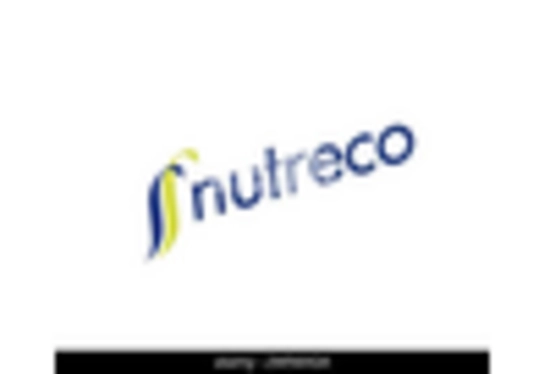Increasing Livestock Production
The increasing demand for livestock production is a fundamental driver of the Organic Acids in Animal Nutrition Market. As the global population continues to grow, the need for animal protein is rising, prompting producers to enhance livestock productivity. Organic acids play a vital role in this context by improving feed efficiency and promoting overall animal health. Market data indicates that the livestock sector is expected to expand, with projections suggesting a rise in meat and dairy consumption. This growth necessitates the use of effective feed additives, such as organic acids, to meet production targets while ensuring animal welfare. Consequently, the escalating demand for livestock products is likely to propel the adoption of organic acids, thereby shaping the future landscape of the Organic Acids in Animal Nutrition Market.
Regulatory Support and Standards
Regulatory support and the establishment of standards for organic acids are crucial drivers in the Organic Acids in Animal Nutrition Market. Governments and regulatory bodies are increasingly recognizing the benefits of organic acids in promoting animal health and food safety. This recognition has led to the formulation of guidelines that encourage the use of organic acids as feed additives. Market data reveals that regions with supportive regulatory frameworks are witnessing a surge in the adoption of organic acids, as producers seek to comply with safety and quality standards. This regulatory backing not only enhances consumer confidence but also stimulates market growth by providing a clear pathway for the integration of organic acids into animal nutrition practices. Therefore, regulatory support is likely to remain a significant factor influencing the Organic Acids in Animal Nutrition Market.
Rising Awareness of Animal Health
The increasing awareness regarding animal health and welfare is a pivotal driver in the Organic Acids in Animal Nutrition Market. As consumers become more conscious of the quality of animal products, there is a growing demand for feed additives that promote health and prevent diseases. Organic acids, known for their antimicrobial properties, are increasingly utilized to enhance gut health and improve nutrient absorption in livestock. This trend is reflected in market data, which indicates that the organic acids segment is projected to grow at a compound annual growth rate of approximately 6% over the next few years. Consequently, the emphasis on animal health is likely to bolster the demand for organic acids, thereby shaping the dynamics of the Organic Acids in Animal Nutrition Market.
Shift Towards Sustainable Practices
The shift towards sustainable agricultural practices is significantly influencing the Organic Acids in Animal Nutrition Market. As the agricultural sector faces pressure to reduce its environmental footprint, organic acids are emerging as a viable solution. These compounds not only enhance feed efficiency but also minimize waste and reduce the reliance on synthetic additives. Market data suggests that the adoption of organic acids can lead to a reduction in greenhouse gas emissions from livestock, aligning with global sustainability goals. This trend is likely to drive investments in organic acid formulations, as stakeholders seek to meet both regulatory requirements and consumer expectations for sustainable animal husbandry. Thus, the sustainability movement is expected to play a crucial role in the growth trajectory of the Organic Acids in Animal Nutrition Market.
Technological Advancements in Feed Production
Technological advancements in feed production are reshaping the Organic Acids in Animal Nutrition Market. Innovations in processing techniques and formulation strategies have led to the development of more effective organic acid products. These advancements enable better stability and bioavailability of organic acids in feed, enhancing their efficacy in promoting animal health. Market data indicates that the integration of technology in feed production is likely to increase the adoption of organic acids, as producers seek to optimize feed formulations for improved performance. Furthermore, the rise of precision nutrition, which tailors feed to the specific needs of animals, is expected to further drive the demand for organic acids. Consequently, technological progress is poised to be a key driver in the evolution of the Organic Acids in Animal Nutrition Market.


















Leave a Comment